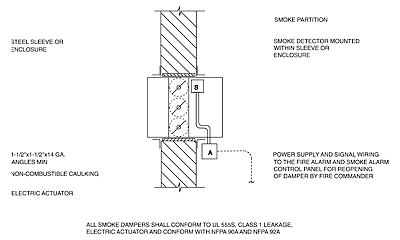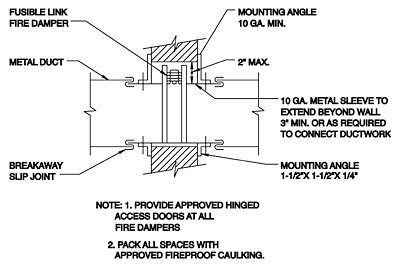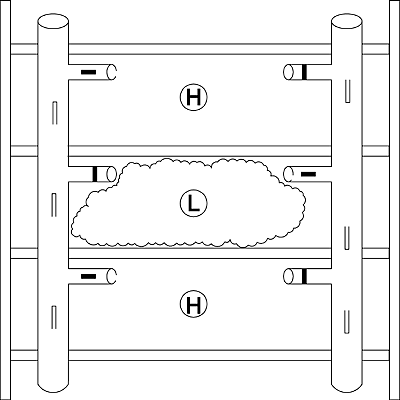

Codes & Standards
Codes and standards impact the design of mechanical and electrical building systems. Several industry standard institutions exist, and these differ according to their design application and geographic jurisdiction. Depending on building location, local fire and safety codes will specify adherence to various industry standards.Regionally, three fire and smoke design codes cover areas of the United States. The Building Officials and Code Administrators International (BOCA) primarily covers the Northeast. The Southern Building Code Congress International (SBCCI) is for Southern states. And the International Conference of Building Officials covers West Coast states. Probably in two years these three code agencies will become one, as pertains to their general present acceptance of "International Codes" which they are adapting.
These codes make reference to mainly three national groups providing fire protection and smoke management codes and standards. These are the National Fire Protection Association (NFPA), Underwriters Laboratories (UL), and the American Society of Testing Materials (ASTM).
The major basis of all codes is the NFPA 101 Life Safety Code. It is comprised of fire protection protocols of the NFPA, materials standards of ASTM, and component standards of UL. For example, Underwriters Laboratories specifies standards and labeling for dampers, such as Fire Damper UL 555 and Smoke Damper UL555S. The NFPA 101 Life Safety Code is referenced within local jurisdictions, and the above mentioned regional code groups.
It is important to note that codes and standards are regularly updated and revised. The revision usually does not affect existing systems. Normally, older buildings are maintained with existing fire control management until such time as building modifications are made. When modifications are made to existing systems, they must conform to the latest code revisions.

Background To The Latest Code Requirements
The 1970s brought major revisions to the life safety code with the advent of smoke control technology and universal use of sprinklers in most building occupancies. In 1975, ASHRAE presented New Techniques for Life and Fire Safety in Buildings. These 1970s technologies incorporated several features:
- Compartmentalization of ventilation systems to provide safe areas of refuge, or an automatic fire suppression sprinkler system.
- Both smoke and heat detection alarm systems.
- Fire standpipe and sprinkler alarm systems.
- Alarm and public address systems with a central control station or fire command center.
- A firefighter's telephone system.
- A control system to recall elevators and for fire department access to all floors during a fire alarm.
- Pressurization of stairs in order to provide smoke-free exit passageways to building occupants and firefighters during a fire emergency.
- A smoke control system to prevent dispersion of smoke from a floor on alarm to floors above and below.
- Atrium smoke exhaust systems.
- A stand-by power source to supply the building's life safety systems during failure of a normal source.

Fire & Smoke Control Design Guidelines
Provide fire dampers in all wall penetrations for fire walls rated two hours or greater (Figure 1). A fire damper, labeled with standard UL 555, provides a breakaway connection in ductwork within a fire-rated wall. A damper link will burn at 160°F and close the connection, maintaining the fire wall barrier.Provide smoke dampers in all wall penetrations through smoke barriers and/or partitions (Figure 2). A smoke damper, labeled with standard UL555S, closes a duct connection within a wall when a coupled smoke detector is activated. Combination fire/smoke dampers provide breakaway connection under heat and/or smoke conditions. Independent fire and smoke dampers can be placed in sequence.
Designs of hvac systems more than 2,000 cfm in size are required to include smoke detectors in the discharge air duct (Figure 3). Designs of systems for more than 15,000 cfm require additional placement of smoke detectors and dampers in the hvac discharge and return air paths (Figure 4).
Smoke control systems usually are designed to evacuate a floor area at a rate of six air changes per hour, or 1 cfm/sqft, whichever is greater. For example, one Northeast city's building code requires six air changes per hour (ach) for floor exhaust, and mechanical ventilation of hoistways and elevator shafts at 12 ach, activated by a smoke detector/damper at the top of the shaft.
Smoke control, especially in multiple stories, requires an engineered fire strategy that will put the fire floor under negative air pressure, while the floors above and below are positively supplied (Figure 5). Each floor in a building must be sized for smoke exhaust, where to exhaust, and if dedicated fan equipment is required in addition to the building ventilation capacity.
A gravity smoke ventilation system employing an elevator shaft would include smoke dampers at each floor. Smoke detection on a floor would open the damper to release positive flow air to the shaft for exit at the roof.
Stairwell pressurization, to create smoke-free exit passageways, requires multiple supply air outlets throughout the full height of the stairwell. All building joints surrounding the stairwell must be sealed. In special design cases, like a building atrium, smoke and fire safety guidelines will include fire exhaust as well as makeup air supply. One city's building code, for example, requires that makeup air supply equal to 75% of the required exhaust to be supplied at the lowest level of a building atrium. Atrium designs should include a gravity ventilation system equipped with remote manual controls to remove smoke if the mechanical system fails during a fire emergency.
An engineered smoke and fire control sequence will depend on building size, use, and jurisdiction. The control strategies, described above, can either be manual or automatic. Most jurisdictions want remote capability for manual control, where the firefighter can enter a central command area and control the system components manually.
Most importantly, on detection of fire or smoke, all air systems are to shut down. Then using remote system control, at a command center display board for example, firefighters can then selectively activate a particular exhaust or supply system according to their containment strategies. Firefighters will understand the nature of the emergency condition and how to use the building system to contain and extinguish the fire. Local fire marshal offices regulate and record building smoke and fire control plans, knowing the systems may be employed by city firefighters.

Effective Designs
The impact of smoke and fire management codes on mechanical and electrical building systems should provide for the highest design quality, which will, in effect, protect human life.First and foremost is occupant safety, including firefighter safety. Second is protection of building property. These goals are achieved by meeting safety codes and standards for fire detection, alarm, communication, positive pressure containment, smoke exhaust, security, emergency power generation, and lighting. An engineered sequence of operation and shutdown of the building ventilation system, coupled with remote automatic control, provides firefighters with the most effective and safe means to manage the fire condition. ES
